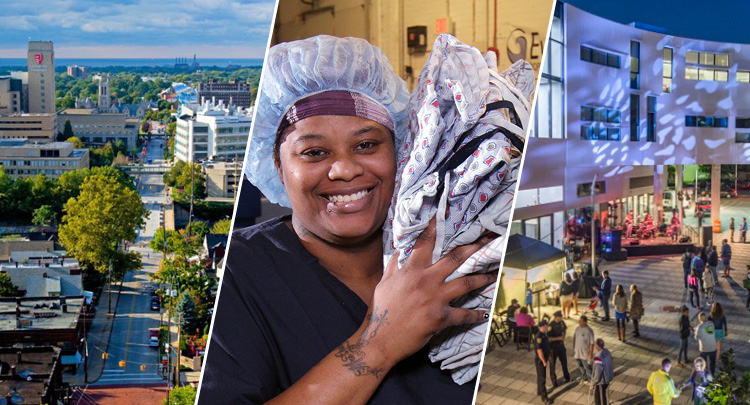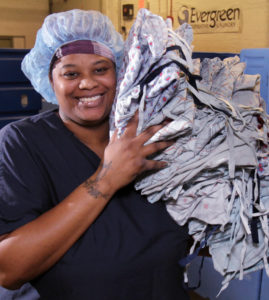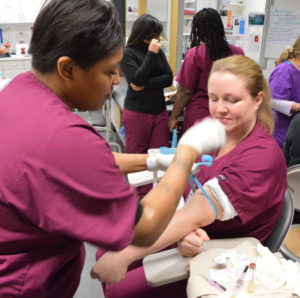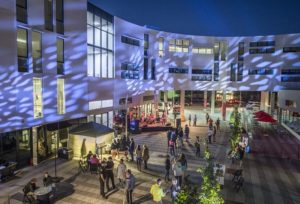Buy Local, Hire Local, Live Local: The Greater University Circle Model for Equitable Development


Cleveland’s Greater University Circle neighborhood has long been considered the city’s premier cultural, medical, and educational district. Home to powerhouse institutions like Case Western Reserve University, the Cleveland Clinic and University Hospitals — not to mention the Cleveland Museum of Art and Cleveland Orchestra, among others — the area is a destination for area residents, students, and visitors alike. These institutions not only draw people into the district, but they are also some of the top economic drivers in the city — spending billions of dollars each year on the goods and services they need to operate.
However, by walking just a few blocks from these institutions, you can find yourself in neighborhoods that have experienced disinvestment for decades — neighborhoods where more than half of the residents are living in poverty and the median household income is less than $19,000 per year.
In many ways, Cleveland serves as a microcosm for some of the historic and systemic forces that have contributed to the growing wealth gap in this country. Cleveland remains one of the most segregated cities in the country, and the scars of redlining and related practices are clearly visible when mapping economic and public health indicators across the city’s neighborhoods.
So, what can be done to bridge these divides and support equitable neighborhood development? In 2005, we launched a bold experiment in Greater University Circle to find out.
The Greater University Circle Initiative (GUCI) was conceived as a redevelopment effort involving public and private partners working together to lift up the neighborhoods surrounding Cleveland’s University Circle district and create meaningful opportunities for area residents. Rather than housing the initiative at a single anchor institution, Community Development Corporation (CDC), or government entity, an innovative decision was made to take a collaborative, multi-anchor approach. The Cleveland Foundation’s role was to bring everyone together, act as lead partner and honest broker, and oversee the initiative’s progress. Other partners in the initiative include anchor institutions like Case Western Reserve University, the Cleveland Clinic, and University Hospitals, as well as public agencies like the Greater Cleveland Regional Transit Authority and the City of Cleveland.
“Rather than housing the initiative at a single anchor institution, Community Development Corporation, or government entity, an innovative decision was made to take a collaborative, multi-anchor approach.”
As the name implies, anchor institutions are rooted in place — they aren’t going to pick up and move anytime soon. They have a vested interest in revitalizing their surroundings and helping to make their neighborhood a better place to live, work and play.
Given their size and scale, these institutions also anchor the local economy. They employ tens of thousands of people, serve millions of people, and spend billions of dollars in procurement each year — the majority of which was historically leaving the area and going to vendors outside the city and county.
The concept behind the Greater University Circle Initiative was simple: if these institutions and their employees were encouraged to buy local, hire local, and live local, we could concentrate their collective economic power to lift up the entire district and transform surrounding neighborhoods. This comprehensive approach to neighborhood development was based on two key convictions:
In 2009, Greater Circle Living was launched as an employer-assisted housing program that offers a consistent incentive package to employees across multiple anchor institutions, encouraging them to live in Greater University Circle neighborhoods. By incentivizing institutional employees to live locally, the program aims to diversify the socioeconomic mix of the surrounding neighborhoods and strengthen the connections between the institutions and the neighborhoods.
Since its launch, the program has supported 859 new residents in Greater University Circle neighborhoods, 79% of whom relocated from other cities, states, and countries. A total of $6.6 million in investments in the program have leveraged nearly $45.8 million in Greater University Circle through home purchase, exterior repair, home improvement, and rental assistance programs.
 In order for the anchor institutions to buy local, they needed reliable vendors nearby that could meet their demand for goods and services. To maximize the benefit of local procurement, a community wealth-building approach was pursued through the creation of new, worker-owned businesses: the Evergreen Cooperatives.
In order for the anchor institutions to buy local, they needed reliable vendors nearby that could meet their demand for goods and services. To maximize the benefit of local procurement, a community wealth-building approach was pursued through the creation of new, worker-owned businesses: the Evergreen Cooperatives.
Modeled on the Mondragon Cooperative network in Spain, the Evergreen Cooperatives include a commercial laundry, a large-scale hydroponic greenhouse, and a contractor service for commercial and residential energy-saving projects.
Today, the cooperatives employ 225 people — 65% of whom are City of Cleveland residents, 83% of whom are racial or ethnic minorities, and 55% of whom are re-entering the community following incarceration. Twenty-one employee homes have been purchased and more than $18.6 million has been injected back into the local economy through Evergreen workers.
Evergreen’s 2019 revenue is forecasted to reach $13 million, with $400,000 in profit distributions to worker-owners. Just last year, Evergreen Cooperative Laundry partnered with the Cleveland Clinic to expand its operations with a new facility in Cleveland’s Collinwood neighborhood. This expansion nearly tripled the size of the laundry in just one year.
Evergreen has also announced the launch of its Fund for Employee Ownership, which helps owners of small and medium-sized businesses transition their companies into worker-owned cooperatives as part of their succession plan.
“GUCI invested in a series of workforce training strategies to help people acquire the skills needed to launch careers at these institutions and earn family-sustaining wages.”
 Two females wearing scrubs in phlebotomy training at NewBridge Center for Arts & Technology To encourage the anchor institutions to hire more local residents, GUCI invested in a series of workforce training strategies to help people acquire the skills needed to launch careers at these institutions and earn family-sustaining wages.
Two females wearing scrubs in phlebotomy training at NewBridge Center for Arts & Technology To encourage the anchor institutions to hire more local residents, GUCI invested in a series of workforce training strategies to help people acquire the skills needed to launch careers at these institutions and earn family-sustaining wages.
NewBridge Center for Arts & Technology was opened in 2010 with investment from a variety of partners. The center offers arts programming for youth as well as adult vocational programs that are specialized based on the hiring needs of the anchor institutions.
The adult programs provide training in phlebotomy and patient care nursing — areas identified as having the most open positions at the Cleveland Clinic and University Hospitals. The programs are tailored to help participants prepare for careers at local hospitals by mirroring the employment requirements of the institutions, offering field experience during instruction, and teaching soft skills throughout all aspects of the training.
NewBridge currently trains 175–200 adults each year in its Phlebotomy and Patient Care Nursing Assistants programs; it has graduated more than 650 students, and 80% of graduates go on to work at University Hospitals and the Cleveland Clinic, with the remainder finding employment at plasma centers, dialysis clinics, and smaller healthcare service providers. In 2018, NewBridge had a job placement rate of 96%.
 Photo of Uptown, a $44 million mixed-use development of housing, dining, and entertainment. In addition to the live local, buy local, and hire local strategies, the Greater University Circle Initiative also focused on connecting people and places through physical development projects and community-building efforts.
Photo of Uptown, a $44 million mixed-use development of housing, dining, and entertainment. In addition to the live local, buy local, and hire local strategies, the Greater University Circle Initiative also focused on connecting people and places through physical development projects and community-building efforts.
Infrastructure projects aimed to improve travel into and around the area and diversify housing and commercial retail options. Uptown, a $44 million mixed-use development completely transformed a main thoroughfare and brought in unprecedented housing, dining, and entertainment right next door to Case Western Reserve University and University Hospitals.
Three major transportation projects were also undertaken, overhauling bus and rapid transit (rail) hubs that had previously hindered connectivity due to safety issues and outdated design.
“[P]hysical connectivity was only part of the equation. Fostering connections between the people who live, work, and visit Greater University Circle was equally, if not more, important.”
These physical development projects not only improved the aesthetic appeal and connectivity of the district, but they offered visible progress that fueled the momentum of the initiative overall.
Revitalizing a community doesn’t happen overnight. Remarkable progress has been made in Cleveland’s Greater University Circle neighborhoods, but there is still a great deal of work to be done to realize the vision of a diverse, vibrant, and connected district. Considering that some of these neighborhoods and residents have been overlooked and underserved for decades, we understand that the process to reverse course is also long-term. However, even as this work continues, the lessons we have learned so far offer a blueprint for other communities.
 Learn more about the Greater University Circle Initiative, including lessons learned along the way, in this case study.
Learn more about the Greater University Circle Initiative, including lessons learned along the way, in this case study.